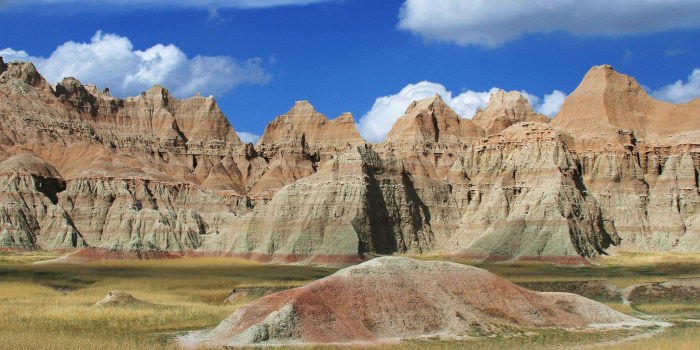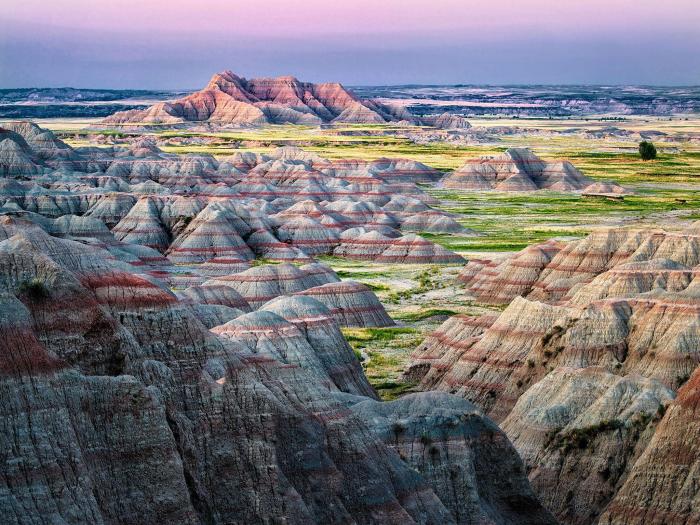Badlands National Park, a mesmerizing canvas of geological formations and a repository of rich human history, beckons explorers to delve into its captivating narrative. Its distinctive landscapes, shaped by relentless erosion, serve as a testament to the transformative power of nature, while the echoes of ancient civilizations add a profound layer of cultural significance.
Within the park’s boundaries, nature’s artistry is on full display, as wind and water have sculpted the soft sedimentary rock into intricate canyons, towering spires, and sweeping prairies. This geological wonderland provides a glimpse into the earth’s distant past, revealing layers of ancient history.
Geology and Geography

Badlands National Park is renowned for its otherworldly landscapes, shaped by millions of years of geological processes and erosion. The park’s unique geological formations and erosion patterns have captivated visitors and scientists alike.
Geological Formations
The Badlands are composed of sedimentary rocks, primarily sandstone and shale, which were deposited over millions of years by ancient rivers and lakes. Over time, these sediments were uplifted and exposed to the forces of erosion, revealing the park’s distinctive layered formations.
- White River Formation: The youngest and most prominent formation, characterized by white and gray sandstone, contains fossils of ancient mammals, reptiles, and birds.
- Brule Formation: A layer of soft, tan-colored shale, known for its abundance of fossil snails and clams.
- Pierre Shale: A dark, marine shale that forms the base of the park’s formations and contains fossilized marine organisms.
Erosion Patterns
The Badlands’ unique erosion patterns are primarily driven by the forces of water and wind. Over time, rainwater seeps into the soft shale layers, causing them to swell and break apart. This process, known as “weathering,” creates vertical cracks and fissures in the landscape.
Once the shale is weakened, wind erosion takes over, carrying away the loose sediment and further sculpting the landscape. This combination of water and wind erosion has resulted in the park’s characteristic “badlands” topography, featuring sharp pinnacles, deep canyons, and rolling hills.
The Badlands National Park, with its rugged buttes and canyons, is a captivating sight. Located in South Dakota, it offers stunning views and unique geological formations. Exploring the park’s scenic trails allows visitors to witness its natural beauty firsthand. After soaking in the wonders of the Badlands, consider venturing to Bari , Italy.
Bari is a vibrant port city with a rich history and culture, providing a contrasting experience to the wild landscapes of the Badlands National Park.
Flora and Fauna

Badlands National Park is a rich and diverse ecosystem that supports a wide range of plant and animal species. The park’s unique geology, climate, and vegetation create a habitat that is home to a variety of wildlife, including bison, prairie dogs, black-footed ferrets, and bighorn sheep.
The park’s plant life is dominated by shortgrass prairie, which is characterized by grasses such as buffalo grass, blue grama, and western wheatgrass. Other common plants include yucca, prickly pear cactus, and sagebrush. These plants provide food and shelter for a variety of animals, including bison, pronghorn, and deer.
Bison
Bison are the largest mammals in North America and are an important part of the Badlands ecosystem. They graze on the park’s grasses and help to maintain the shortgrass prairie. Bison also create wallows, which are depressions in the ground that provide water for other animals. In addition, bison dung provides nutrients for the soil and helps to fertilize the plants.
Human History and Culture

The Badlands National Park has a rich and diverse human history. Native American tribes have inhabited the area for thousands of years, leaving behind a legacy of cultural and archaeological sites. European exploration and settlement in the 19th century had a significant impact on the park, leading to the displacement of Native American tribes and the establishment of ranching and agriculture.
Native American Tribes
The Badlands National Park was home to several Native American tribes, including the Lakota, Cheyenne, and Arapaho. These tribes relied on the park’s resources for food, shelter, and clothing. They hunted buffalo, antelope, and other animals, and gathered plants and berries. The tribes also used the park’s unique rock formations for shelter and ceremonies.
European Exploration and Settlement
European explorers first visited the Badlands National Park in the 18th century. In the 19th century, fur trappers and traders established trading posts in the area. Ranchers and farmers also began to settle in the park, leading to the displacement of Native American tribes. In 1877, the United States Army established Fort Meade in the park to protect settlers from Native American attacks.
Impact of European Exploration and Settlement
The arrival of Europeans had a significant impact on the Badlands National Park. The displacement of Native American tribes led to a decline in the population of buffalo and other animals. Ranching and agriculture also altered the landscape of the park. The establishment of Fort Meade led to the development of roads and other infrastructure in the park.
Tourism and Recreation

Badlands National Park offers a wide range of recreational opportunities for visitors of all ages and abilities. From hiking and biking to camping and wildlife viewing, there’s something for everyone to enjoy in this unique and beautiful landscape.
Badlands National Park is known for its rugged beauty and unique geological formations. The park’s stunning landscapes are best explored on foot or by car, and there are plenty of opportunities for hiking, camping, and wildlife viewing. If you’re looking for a more adventurous way to experience the park, consider booking a guided tour through bancomer.
These tours offer a unique perspective on the park’s history and geology, and they’re a great way to get up close and personal with the wildlife.
One of the best ways to experience the Badlands is on foot. The park has over 100 miles of hiking trails, ranging from easy walks to challenging treks. Some of the most popular trails include the Notch Trail, which leads to a stunning overlook of the Badlands Wall; the Saddle Pass Trail, which takes hikers through a narrow canyon; and the Fossil Exhibit Trail, which features a variety of fossils from the park’s past.
In addition to hiking, visitors can also enjoy biking, horseback riding, and off-road vehicle riding in the Badlands. There are several designated trails for each of these activities, and visitors can choose from a variety of rental options. Camping is also available in the park, and there are several campgrounds to choose from, ranging from primitive campsites to RV hookups.
No matter how you choose to experience the Badlands, it’s important to remember to practice responsible tourism. This means staying on designated trails, packing out what you pack in, and respecting the park’s natural resources. By following these simple guidelines, you can help to protect the Badlands for future generations to enjoy.
Educational and Research Opportunities: Badlands National Park

Badlands National Park is not just a breathtaking landscape; it is also a hub for scientific research and educational programs. The park’s unique geology, flora, and fauna provide an invaluable natural laboratory for scientists and students alike.
The park offers a range of educational programs tailored to different age groups and interests. Guided hikes, ranger talks, and interactive exhibits help visitors learn about the park’s natural and cultural history. For students, the park provides hands-on learning opportunities through field trips, research projects, and internships.
Badlands National Park, known for its rugged canyons and spires, is a geological wonderland in South Dakota. If you’re planning a trip to the Pacific Northwest, consider extending your adventure to Bellingham, Washington. This charming city offers a vibrant arts scene, scenic waterways, and proximity to the breathtaking San Juan Islands.
After exploring Bellingham’s urban delights, return to Badlands National Park for an unforgettable experience amidst its otherworldly landscapes.
Research Facilities and Partnerships, Badlands national park
Badlands National Park boasts state-of-the-art research facilities, including the Badlands National Park Research Station. The research station provides scientists with access to laboratories, field equipment, and expert staff. The park also collaborates with universities, research institutions, and government agencies to conduct a wide range of research projects.
These partnerships allow scientists to leverage the park’s unique environment and resources to study topics such as:
- Paleontology and geology
- Wildlife ecology and conservation
- Climate change impacts
- Water resources management
Importance of Scientific Research
Scientific research plays a vital role in understanding and preserving the park’s unique environment. Research findings help park managers make informed decisions about conservation, restoration, and visitor management. They also contribute to the broader body of scientific knowledge about the Great Plains ecosystem and its history.
Last Point

Badlands National Park stands as a testament to the intricate interplay between geology, ecology, and human history. Its diverse landscapes, rich wildlife, and cultural heritage offer a captivating experience that fosters a deep appreciation for the fragility and resilience of our natural world. As we continue to explore and learn from this extraordinary park, may we strive to be responsible stewards, preserving its wonders for generations to come.
Clarifying Questions
What is the best time to visit Badlands National Park?
Spring and fall offer the most pleasant weather for hiking and exploring the park.
Are there any fees to enter Badlands National Park?
Yes, there is an entrance fee of $30 per vehicle or $15 per person on foot or bicycle.
What are some of the most popular hiking trails in Badlands National Park?
The Notch Trail, the Cliff Shelf Nature Trail, and the Saddle Pass Trail are among the most popular and scenic trails.